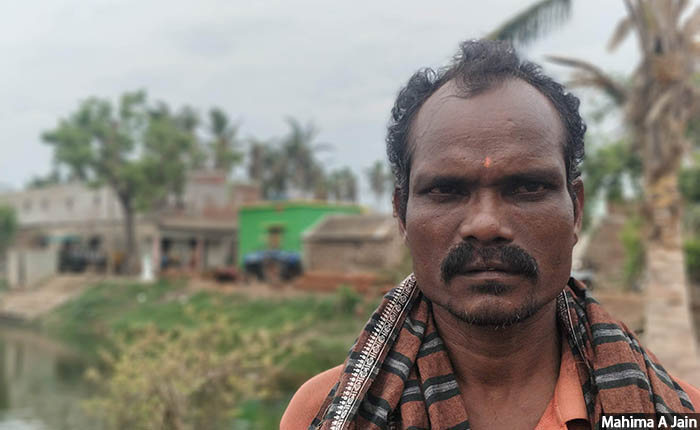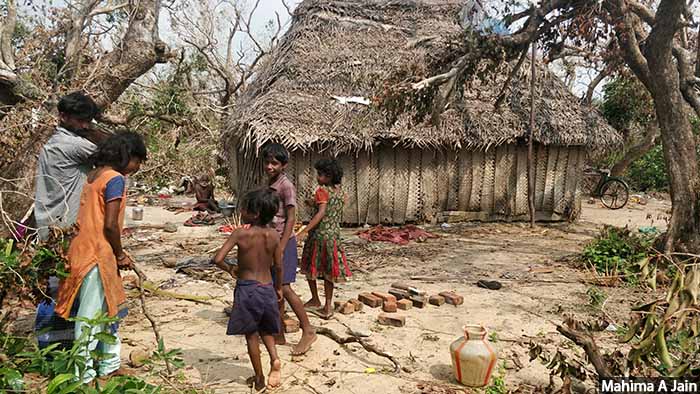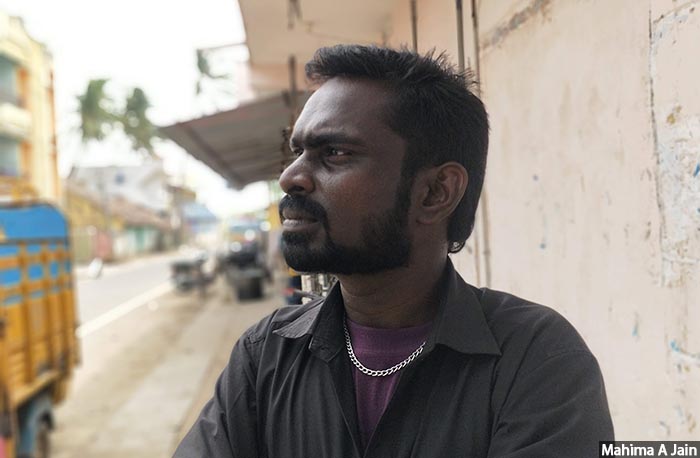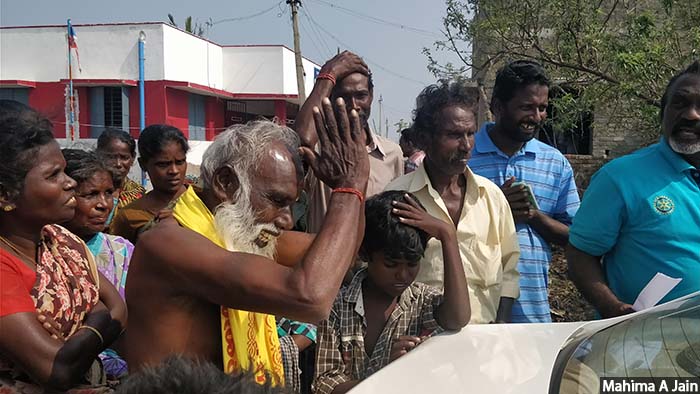When Cyclone Fani hit Odisha’s coast in May 2019, it destroyed the lives and properties of 16 million people. But the worst-affected were its Dalit landless farm workers who are forced to live on the margins of villages where relief reaches last. This was also the case in the coastal villages of Nagapattinam in Tamil Nadu where after Cyclone Gaja, relief material reached the more affluent areas first. Mahima A. Jain (Freelance Journalist, India) travels to these villages and find that not only are the marginalised communities most vulnerable to climate-related disasters but they also have the least ability to recover from them.
Brahmagiri, Puri District: There’s nowhere to go beyond Talamala. It is the last village in Puri district’s Brahmagiri block in eastern Odisha, sandwiched between the Bay of Bengal and the Chilika lake.
When Cyclone Fani swept through Talamala at 240 km/h on May 3, 2019, it flattened the village of just over 4,000 people. Crops, cultivated predominantly on small and marginal landholdings of 2 hectares or less, were completely destroyed.
Sridhar Sethi, 45, and his wife did not even have that much land to lose. They are landless labourers and Scheduled Castes (SC), the most disadvantaged communities in the Hindu caste hierarchy. The couple are also disabled.
The Sethi family lived in a kutcha house, a makeshift structure made of low-quality materials and thatched roof, working as farm labourers at less than the minimum wage of Rs 375 because of their disability.
“Since Fani, I have no money to make ends meet, we have no food, water, or shelter,” said Sethi, who now lives with his family in a makeshift tent. He took refuge in the battered relief shelter on the eve of the cyclone which affected 16 million people and led to the largest evacuation of its kind–nearly 1.5 million people.
Sethi and others like him who make up the bulk of India’s lower castes, nearly 16.6% or over 200 million, are not only the most vulnerable to climate-related disasters but also have the least ability to recover from them because of their precarious position–on the very edge of society.
 Shridhar Sethi, a Dalit landless farm worker, and his family have returned to the ruins of their hut destroyed by Cyclone Fani. “Since Fani, I’ve no money, food, water or shelter,” he says.
Shridhar Sethi, a Dalit landless farm worker, and his family have returned to the ruins of their hut destroyed by Cyclone Fani. “Since Fani, I’ve no money, food, water or shelter,” he says.
In our investigations across the coastal villages of Nagapattinam district in Tamil Nadu and Puri, we found that socio-economic factors, such as the compulsion to stick to caste-based occupations and the pressure to live in the most vulnerable parts of the village, further marginalise farm labourers during disaster relief.
“The caste system is vital to understand the way it might manifest before, during and after a disaster,” says Nibedita Ray-Bennett, associate professor in risk management at the University of Leicester and the founding president of the Avoidable Death Network, a global organisation dedicated to reducing global disaster deaths. “In rural India, the geography of a village and the caste system go hand in hand, sometimes intensifying the experience of caste.”
Upper and middle castes in coastal villages live in elevated areas and own concrete houses and this helps them deal better with disasters, Ray-Bennett found during her fieldwork in Jagatsinghpur district of coastal Odisha in 1999 in the aftermath of the 1999 super cyclone. In contrast, lower-caste day labourers who live on the edges of villages, in low-lying areas, have a tougher time recovering from disasters.
This village geography, determined by caste, is visible across other states as well, said Ray-Bennett. “The way in which different castes inhabit a particular location exacerbates the impact or minimises the impact of the disaster,” she explained.
Not everyone equally vulnerable
So, while Fani caused widespread destruction, not everyone experienced the same level of vulnerability and not all had the same access to relief measures.
Almost 88% of the SCs are poor and face multidimensional vulnerability, according to the 2007 Arjun Sengupta Committee Report. Stranded at the bottom of India’s agricultural economy, labourers like Sethi are economically the most vulnerable and unable to secure even the minimum standard of living, the report noted. Unlike any other social group, nearly 63% of Scheduled Castes are wage labourers, according to the National Sample Survey Office’s 68th round (2011-12).
When a disaster hits, the government’s priority is preventing deaths, followed by the provision of relief material. Officially, Sethi would be listed as a success story: He and his family were evacuated in time and provided the universal relief–50 kg of rice and Rs 2,000.
But disaster risk reduction has moved beyond just evacuation and immediate relief.
“While speedy relief such as giving temporary shelter is critical and seen as desirable by the government, it is not aligned with international principles of disaster risk reduction that call for inclusive and long-term recovery,” said Chandni Singh, co-lead of Recovery With Dignity, a project at the Indian Institute for Human Settlements (IIHS) and the University of East Anglia, UK.
The project examines post-disaster recovery processes across Odisha, Tamil Nadu and Kerala, to understand how different representations of disaster-affected populations affect recovery outcomes. Assessing the extent of damages and providing relief is only the first step and it must be followed with identifying affected populations and providing longer-term rehabilitation that address existing and emergent vulnerabilities, Singh explained.
Relief material dwindling, no jobs, no power
Farmers in several villages that IndiaSpend visited are desperate. Cyclone Fani had completely destroyed coconut, banana and paddy farms, and contaminated the water supply. The heat wave that followed the cyclone, predictions of a poor monsoon, and a two-month long powercut have added to the suffering caused by Fani.
Nearly 86.2% farmers in India belong to the small and marginal category, but own just 47.3% of the crop area, the 10th Agriculture Census (2015-16) revealed. Dalits own only 9% of cultivable land, and nearly 61% of it is smaller than 2 hectares.
The Bhoi household in Rebana Nuagaon, closer to the coast, is still struggling to recover from Fani. In the village, kutcha and semi-permanent huts are shared by families working as agricultural labourers and sharecroppers. Pucca houses rise from the neighbouringing plots.
Thirty-eight year-old Shiva Bhoi’s hut–and its store of grains and cooking vessels–had been destroyed by Fani. All six members of his family have returned to the ruins of their hut but Bhoi is worried about the future–the crops have failed due to the cyclone and the 50 kg of rice that came as relief material is running out fast. “It will last another 10 days, maybe,” Bhoi said. With no daily work in sight, these farmers are taking it one day at a time, hoping that this year’s monsoon does not flood their low-lying farm lands and push them further into deprivation.
‘Upper castes didn’t want to share the shelter with lower castes’
Pre-existing conditions of vulnerablity and caste-discrimination get magnified and multiplied as systemic and social exclusion during disasters, noted a 2011 study conducted by National Dalit Watch (NDW), which documented caste-based discrimination at relief camps and while accessing aid.
A similar story played out in Nagapattinam district in Tamil Nadu. At the tail-end of the Cauvery Delta, where nearly 32 rivers, including the Cauvery, criss-cross the district before entering the Bay of Bengal. Large lush fields in its northern villages contrast with the barren landscape around Chettipullam, around 45 km south-west of the district headquarters.
This is where Birla Thangadurai, 35, lives, 20 km from the point where Cyclone Gaja made landfall in November 2018 at a speed of 140 km/h.
 A family of Dalits living on temple land in Thiruppondi West return home weeks after Cyclone Gaja hit Tamil Nadu’s Nagapattinam district in November 2018. These settlements, usually built outside the village, take the brunt of the damage caused by cyclones.
A family of Dalits living on temple land in Thiruppondi West return home weeks after Cyclone Gaja hit Tamil Nadu’s Nagapattinam district in November 2018. These settlements, usually built outside the village, take the brunt of the damage caused by cyclones.
“On the first day we had to save our lives, so no one was looking at castes,” recalled Thangadurai, a member of the Nagapattinam collectorate’s board for SC/ST monitoring. “But once survival was ensured, caste issues flared up.”
His fellow villagers are either agricultural labourers or sharecroppers. “Relief material came through the main roads and people in interior areas, like ours, could not access it,” he said. “You have to cross so many upper caste villages before you reach our village. Relief may be caste-blind, but the local situation is not.”
The vans bringing the relief material into the villages had to be guarded and escorted because the more powerful communities living en route would stop the vehicles and take the materials, recalled Thangadurai.
Thangadurai’s experience captures what academics like MN Srinivas, Kathleen Gough and Andre Bettile found while studying the Cauvery Delta: Those from the Scheduled Castes live in clusters of densely packed, small houses outside the main village while upper and intermediary castes–that often own fertile farms–live in spacious home close to main roads.
 “Once survival was ensured, caste issues flared up,” says Birla Thangadurai, a member of the Nagapattinam collectorate’s board for SC/ST monitoring. Vehicles carrying relief material had to be escorted so powerful communities living en route would could not stop them.
“Once survival was ensured, caste issues flared up,” says Birla Thangadurai, a member of the Nagapattinam collectorate’s board for SC/ST monitoring. Vehicles carrying relief material had to be escorted so powerful communities living en route would could not stop them.
Within weeks of Fani and Gaja, the media reported cases of caste discrimination over which groups would receive aid supplies first at cyclone shelters.
Kaviarasi, the village administrative officer in Periyathugai, Nagapattinam district, had to tread carefully around caste issues at the shelter. Most villagers are small and marginal farmers, but around 3% are Scheduled Caste agricultural labourers. Dalits live on the outskirts of Periyathugai and do not have access to any public spaces apart from Kaviarsi’s office. And when the disaster forced upper and lower castes to mingle at the relief shelter, the divisions did not disappear.
“Upper castes did not want to share the shelter with lower castes,” Kaviarsi recalled. “We had to put both groups on different floors and food was cooked separately.”
Multiple forms of marginalisation–social, spatial (living in peripheries of the village), occupational (waste pickers, daily wage labourers)–make Dalits more vulnerable to disasters, whether human-made or natural, noted the 2014 Equality in Aid report by International Dalit Solidarity Network. They have less access to information, public education, disaster resilient infrastructure or communication for immediate action.
Repeated cyclones, those on the coastal margins hit worst
Nearly 17% of Indians live along the 7,500-km coast, which receives 10% of the world’s tropical cyclones and are hit by nearly two to three severe ones annually. Both Odisha and Tamil Nadu, where SCs account for 17% and 20% of the population or 2.16 million people as of 2011, have recurrently been hit by cyclones.
Between 1891 and 2002, 98 cyclones made landfall in Odisha, the most any Indian state has faced, and 54 in Tamil Nadu. Around 370 million people were exposed to cyclones in India between 1980 and 2000, data showed.
As the planet warms, the total number of tropical cyclones is expected to decline, but an overall increase in severe cyclones, specifically in north Indian Ocean (which includes the Bay of Bengal and Arabian Sea), has been predicted by the 2018 Intergovernmental Panel For Climate Change’s Special Report on Global Warming of 1.5oC.
The predictions also include an increase in coastal flooding, storm surges and sea level rise along India’s coast, affecting millions of people. States along the Bay of Bengal, particularly Tamil Nadu, Andhra Pradesh, Odisha, West Bengal and Puducherry, are highly vulnerable to cyclones, as per the National Disaster Management Plan (NDMP) released in 2016.
‘Disaster management must mind vulnerabilities’
India’s Disaster Management Act 2005, the NDMP and Odisha’s Relief Code, and the recent pioneering work done by the India Meteorology Department on early warning systems are great measures but the disaster management system in India still tends to be reactive, said Ray-Bennet. But there is one drawback.
“Caste, class and gender yardsticks are mentioned in the Act and the Relief Code, but often remain as rhetoric,” she said. “We need to be more mindful and sensitive to different vulnerabilities. Disaster management organisations and the state and local governments need to go deeper to tease out the very complex sociological elements of Indian society and bring that to the heart of everyday disaster management practices to promote disaster-resilient sustainable development in the villages and district towns of India.”
Prema Revathi runs Vanavil, an NGO-cum-school for children from nomadic Scheduled Tribes set up after the 2004 tsunami and pointed out how little awareness there is of caste discrimination in relief work.
“People in urban areas think they have done their bit by donating some money or material,” Revathi said. “But the way relief supplies get distributed after a disaster are really a function of the caste system. Sometimes supplies don’t even reach the most deserving simply because they aren’t well-connected.”
Prioritising wealthier areas in relief work further endangers the poor
Growing levels of climate change will have devastating consequences for people in poverty, the latest UN special report, titled Climate Change and Poverty, stated. In 2017, 18.8 million people–twice the number displaced by wars, and the majority from developing countries–were displaced due to disasters in 135 countries, the report said. The history of prioritising wealthier areas for protection has further endangered people living in poverty, it added.
“Climate change is, among other things, an unconscionable assault on the poor,” the report concluded.
The Sendai Framework for Disaster Risk Reduction 2015-2030, adopted by UN member states, sets out seven clear targets and four priorities to prevent new disaster risks and reduce existing ones. It prioritises disaster governance at multiple levels and emphasises the need to understand disaster risk in all its dimensions. But aspects of Indian society, such as caste, which are fundamental to understanding how experiences during disasters differ, are not mentioned in any international framework or policy.
How to decide who is most deserving
“We can evacuate 1 million people and take care of them at any given point,” said Bishnupada Sethi, managing director, Odisha State Disaster Management Authority (OSDMA). “That is good management. From 1999 (when the super cyclone killed 10,000 people in Odisha) to now–it’s a huge change. Now, we are able to save lives.”
The turning point in this improvement came after two big disasters–the super cyclone and the tsunami, according to Singh. But disaster risk reduction also needs preparation for long-term impacts, having mechanisms for dealing with psychological impacts and trauma, and reconstruction of lives and livelihoods, among other things, she added.
 Dalit villagers in Kodiyakarai in Nagapattinam district request relief workers to represent their case to the government. Relief work does not distinguish between castes, say government officials, but social complexities cannot be ignored, counter scholars.
Dalit villagers in Kodiyakarai in Nagapattinam district request relief workers to represent their case to the government. Relief work does not distinguish between castes, say government officials, but social complexities cannot be ignored, counter scholars.
“When everyone seems to be impacted, how do you assess who’s the most deserving?” Singh asked. That is a question she has asked multiple government and non-government stakeholders and finds that often, relief is not prioritised on the basis of pre-existing vulnerability such as caste. While such universal coverage allows for faster relief and wider coverage, it can often overlook differential vulnerability and the need to give more assistance to those who are hit harder or recover more slowly.
“In disaster management we don’t think about minorities or majorities, rich or poor,” said Laxminarayan Nayak, state project officer at the OSDMA. “All people in the district are eligible for relief.”
Odisha’s mandatory quota of 50 kg of rice and Rs 2,000, for example, was provided to everyone in affected districts. Caste was not overtly included in these calculations but policies did indirectly take into consideration the needs of those of marginalised castes, he added.
But neglecting the caste structures and its impact on disaster relief invariably leads to discrimination and exclusion of Dalits, the 2011 NDW report noted.
“Our take from recent cyclones is that the government is currently ill-equipped to capably or adequately handle rehabilitation or relief assessment of landless and assetless labours,” said Radhika Ganesh, part of the NGO Kaani Nilam (Ek Potlee Reth Ki), and the co-author of a report which mapped the relief needs of over 2,700 families, mainly landless labourers, in 13 villages immediately after Cyclone Gaja. The inclusion of small and marginal farmers, and landless farm workers in post-disaster work is an important way of providing immediate income to many, she pointed out.
Back in Talamala, damages have been assessed but no help has come from the government. Sethi stands amidst villagers, almost all upper caste men. The Centre for Youth and Social Development, a Bubaneshwar-based NGO, will be building him a cyclone-resistant home. Some villagers are envious and make jibes about this. But till his new home is ready, Sethi and his family can only hope to survive another day in a makeshift tent and no resources except meagre daily earnings.
This article gives the views of the author, and not the position of the South Asia @ LSE blog, nor of the London School of Economics.
This piece first appeared on IndiaSpend on August 13 2019. Reporting for this story was supported by Internews’ Earth Journalism Network.






